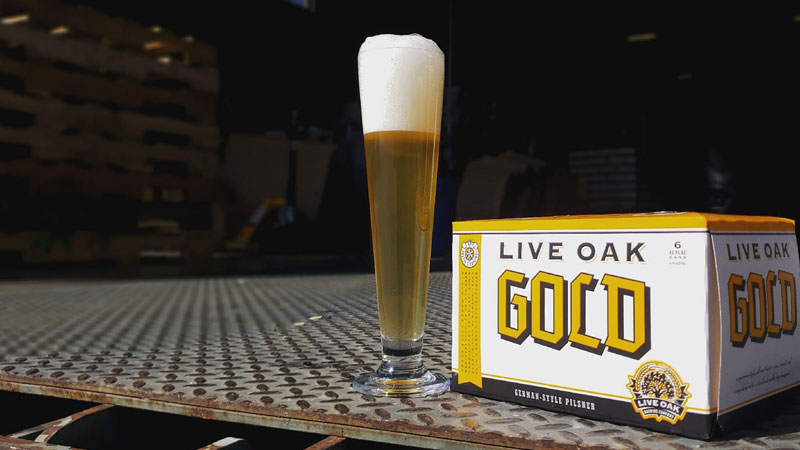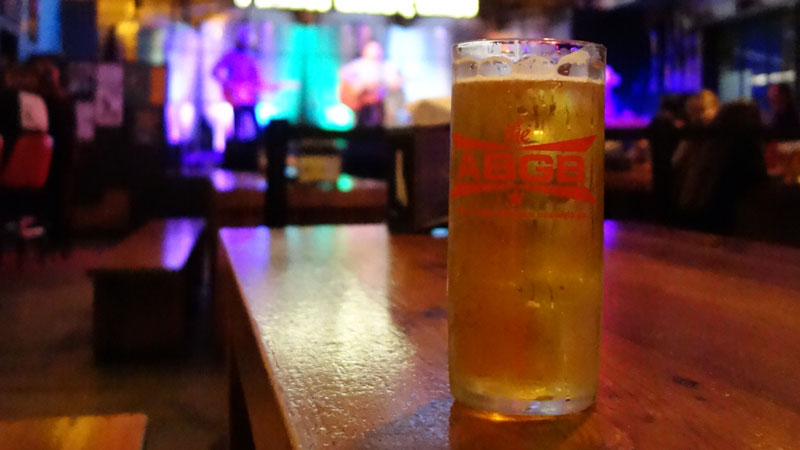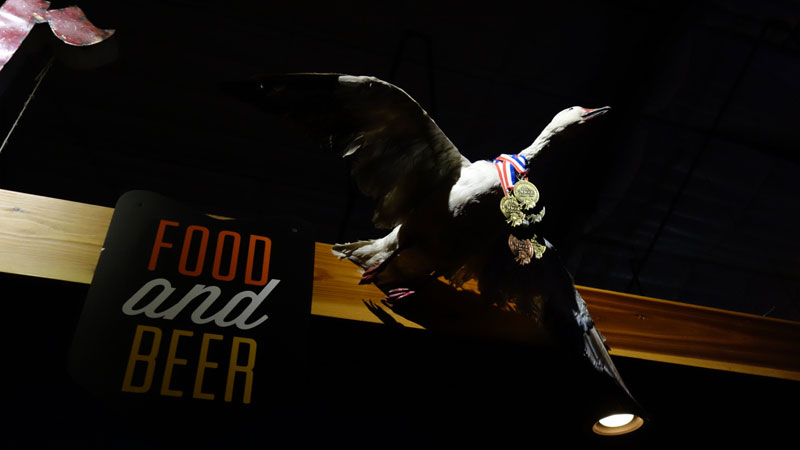At the 2018 Great American Beer Festival (GABF), Texas breweries took home close to 20 medals, more than a third of which were for lagers. In the festival’s 30-year history, the state has earned close to 100 medals across the lager category. Several breweries claim repeat GABF wins.
This is no coincidence. Texas’s thirst for pilsner, Helles, and Oktoberfest goes back much further than GABF, which was founded in 1982. Longstanding Texan communities, including those with German, Czech, and Mexican heritage, create and shape the market for this beer category. And according to Laura Christie, owner of Hopsimath, a beer education company based in Austin, Texans’ centuries-long love for lagers can be attributed to “a combination of two things: German immigration, and Texas weather being so so frickin’ hot.”
Claim to Fame
Austin Beer Garden Brewing Co. (the ABGB) won two GABF golds in 2018, one for its Hell Yes Munich-style Helles lager, and another for Rocket 100, an American-style pilsner. The brewery has scooped up seven GABF medals since 2015. Six were golds and all were for lagers.
Texas Beer Co. of Taylor, Tex., also won a gold medal in 2018 for its Pecos Amber Lager. That same year Austin Beerworks took home a bronze for its Super Awesome Lager; and Ranger Creek Brewing & Distilling of San Antonio won gold for its San Antonio Hatch Lager (this one, oddly enough, in the chili beer category). Also last year, Rahr & Sons Brewing of Fort Worth, and Oak Highlands Brewery of Dallas, won gold and bronze, respectively, for their Oktoberfests.
Accolades for Texas lager brewers extend beyond GABF, too. VinePair named Live Oak Brewing of Del Valle, Tex., among the Best Breweries in America in 2018. Pinthouse Pizza’s Sw’Elsinore Canadian Lager and Brewtorium’s Electric Lederhosen are among the top-rated lagers on popular beer review app Untappd. Both breweries are located in Austin. And last year, Men’s Journal named The Brewer’s Table’s Vor Ort pale lager the best beer in Texas.
History of Lager in Texas
Craft lagers are currently a nationwide trend, but they’ve been central to the Texas palate since the mid-1800s. The Texan preference for lagers dates to 1840, when German and Czech immigrants began settling in the state.
“Before 1840, there wasn’t a ton of German immigration [in Texas],” Christie says. However, after 1840, “a wave of German immigrants” flooded the state, lured by inexpensive land and a bit of homesickness. “Supposedly, Hill Country reminded Germans of Bavaria,” Christie says, and the water was “a little bit harder, like in Bavaria.”
Czech immigrants also arrived in Texas in the mid-1800s, motivated by an “abundance of good, relatively inexpensive farmland in Texas,” according to the Texas State Historical Association (TSHA). They likely brought with them the Czech, or Bohemian, pilsner.
“Texas’ German and Czech heritage speaks strongly [about the region’s brewing culture], from Pearl Brewing’s foundation [in the 1880s] to the last 20 years of Live Oak Pilz,” Dusan Kwiatkowski, head brewer at Live Oak, told the Austin Chronicle in 2016. German- and Austrian-influenced lagers were simultaneously developing in 19th-century Mexico, from which the United States officially annexed Texas in 1845. The style gained popularity “when Austria’s Maximilian I declared himself emperor of Mexico in 1864,” bringing with him “his nation’s newly beloved Vienna lager,” which became the dominant beer style in Mexico, CraftBeer.com reports. It later evolved into its own style, the Mexican lager, which is now dominated by such familiar brands as Corona, Modelo, Dos Equis, and Tecate, as well as American-born craft Mexican-style lagers.

“Early settlers set the cultural tone for these regions going forward,” Christie says. “The East Coast saw mostly English settlers, who brewed ales,” while German and other central European settlers brewed lagers.
According to the TSHA, 1883 was a pivotal year for Texas beer. At that time, German-born Adolphus Busch brought his brewing technology to San Antonio and opened Lone Star Brewery, Texas’s first large-scale beer operation. Between 1890 and 1918, there were an estimated 43 breweries in Texas.
Sadly, many shuttered before and after Prohibition due to competition from larger breweries. By 1983, six breweries remained in Texas: Anheuser-Busch, Miller, Schlitz, Lone Star, Pearl, and Spoetzl Brewery, makers of Shiner beer, which was founded by German and Czech immigrants. All of them brewed lager.
Big Business
Texas was also a “friendly” place for beer businesses, Christie says. “When the big guys like Miller were looking to expand, they found Texas very favorable economically,” she says. Along with access to ports, setting up factories in cities like Houston and Dallas was a “big opportunity because there are so many people,” she says.
Craft lagers began proliferating in the 1990s after a 1993 law passed allowing restaurants and bars to produce and sell their own beer on site. Live Oak, which opened in 1997, was Austin’s first lager brewery to debut after the new legislation.

Several other breweries followed suit, many of which featured lagers among their initial offerings. This provided locals with “a good transition into craft,” Christie says, offering something “approachable” to the general beer-drinking public. In lagers, “there are not a lot of intense flavors,” she says. At the same time, brewers and beer geeks recognize that “clean lagers are super hard to make.”
The ABGB has been successful with lagers, Brian “Swifty” Peters, owner and brewer of the ABGB, writes VinePair in an email. “We have always maintained that we have a lot to learn, since the Germans have an (over) 500-year head start. None of us here have been trained in Germany,” he writes.
As a result, Peters says, Texas brewers are particularly devoted to perfecting their lagers. The styles require more time, money, and expertise to make than ales.
“It’s not easy because the craft industry is built around ales,” he says. “The equipment is designed for ales, the readily available ingredients are designed for ales, the consumers mostly want ales.” In short, he says, “There is very little incentive to make lagers.”
“Craft brewers around the state take the style very seriously, and don’t typically set out to make a bland, light, adjunct-filled beverage,” Pam Catoe, Craft Beer Austin contributor and a regional editor for PorchDrinking.com, tells VinePair. “You’ll also find a wide variety of lager styles at just about every craft brewery you visit,” she says. Austin even hosts a festival devoted to lagers, the Lager Jam, each summer. The festival pours more than 20 lagers from local breweries.
Newcomers with Mexican heritage include El Paso Brewing, which was established in 2016 and brews El Matador Mexican Vienna Lager. Ode Brewing, founded in 2015, calls its Porch Pounder Pils “a German pils with an El Paso twang.” Deadbeach Brewery, established in 2013, offers a “Southwest lager,” a Helles lager, an American light lager, and an amber lager infused with apricots.
A Hot Commodity
It’s difficult to ignore the Texas weather. “It’s hot as hell here in Texas,” Catoe says. “It’s hard to get your mind around how oppressively hot it is here in the summer until you experience it.” The state of Texas is larger than France, and July temperatures range from 91 in the northern panhandle and Houston, to 96 in Austin and Dallas, to 97 in El Paso. Characteristically refreshing and easy to drink, lagers are an ideal thirst-quencher.
Compared to trendier craft beer styles like hazy IPAs, “lagers are more well-suited to enjoying while sitting outside in the sunshine,” Brittany Lajoie, general manager of Remnant Brewing in Somerville, Mass., who recently visited Austin, says. “There isn’t as much hop particulate that will transform into a less attractive aroma in the sun,” she adds. “I love an awesome NEIPA, but when I’m in the South, I’ll order a lager every time.”

Texas brewers continue to focus on lagers because they’re what Texans want to drink.
“If the local people are already accustomed to German beer styles, and the local brewers recognize this, then it isn’t surprising they have a special interest to make a better version of one of those styles,” Guy Bartmess, brewmaster of Garage Brewing in Murrieta, Calif., writes VinePair in an email. Garage Brewing won a GABF gold for its Classic Lager, a Munich Helles lager, in 2015. Bartmess, who spent summers in Texas with a friend whose family is of German heritage, recalls their connection to tradition. “It seems all across Texas many of the people who have family ties to Germany have not forgotten that fact. It would not be surprising, then, that craft brewers in Texas also want to embrace German brewing traditions.”
“We can make any beer style we want, but because we are a business, you aren’t going to keep making it if people don’t buy the product,” Bartmess says. “If you win a series of medals for a specific beer, but nobody buys it, you won’t keep making it, and it probably won’t get made by other breweries in the area as well.”
Beer Necessity
Like bagels in New York, fried chicken in Kentucky, or lobster in Maine, Texas’s love for lagers goes deeper than recent tastes. Cultural ties to its German and Czech brewing traditions, a border with Mexico, and oppressive heat all contribute to the seemingly unanimous embrace of the easy-drinking lager beer.
In Texas, lager isn’t a trend. It’s a necessity.
